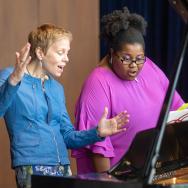Editor’s note: This story is part of Dispatches from Abroad, a series highlighting UChicago community members who are researching, studying and working around the world.
Each morning Baldwin Giang wakes up, walks to the window and looks out over Janiculum Hill, the highest point in Rome. Though his day will surely involve composing music, the University of Chicago graduate student isn’t interested in staying locked inside a studio when the city is at his fingertips.
“Rome is really exciting because it's the kind of place where you can be constantly surprised if you open yourself up to it,” Giang said.
A Ph.D. student in the Department of Music, Giang is a composer, pianist and multimedia artist. He composes for many types of ensembles: small and orchestral, vocal and electronic. His work has been described by UChicago composer Prof. Augusta Read Thomas (Giang’s dissertation advisor) as a marriage of “an adventurous mind with incredibly tight craft.”
In 2023, Giang was awarded the nationally competitive Samuel Barber Rome Prize, granting him a year of “time and space to think and work” at the American Academy in Rome. Fellows work across disciplines ranging from design to ancient studies to visual arts.
While in Italy, Giang is composing several projects, including one inspired by the novel “Call Me by Your Name.” But his time is equally spent on using the fellowship’s other opportunities to inform his practice: creative shop talks with his cohort, community events and the freedom to explore.
“For me, the special part of coming here is being around these other fellows and getting to engage with the city of Rome,” Giang said.
When in Rome
Typically, Giang bookends his day composing in his studio. However, in the afternoons and evenings he’s often out exploring the city and meeting people. An art gallery visit can lead to an invitation to a performance; a conversation at a party can lead to a future collaboration.
Mealtimes at the Academy are especially important—not only for the garden-fresh food, but also to spend time as a cohort. Dinners are two-hour affairs, Giang says, where plates of hand-made pasta and conversation circulate freely. It’s these moments where fellows can dive deep and seek opportunities for collaboration.
One such project is a commission for the New York ensemble loadbang. Though he composes for voice, Giang doesn’t write lyrics. This provided the perfect opportunity to collaborate with another fellow: noted novelist Katie Kitamura.
“Reading Katie’s text lights up the words in a certain way, but then when I add my music, it lights it up in a totally different way,” Giang said. “That's the kind of collaboration that the Academy really tries to foster—people engaging each other from different disciplines and stepping outside of their comfort zone.”
San Clemente Syndrome
Giang is also drawing inspiration from Rome’s architecture, composing a piece inspired by the Basilica San Clemente. Above ground, the church is a medieval Catholic basilica, but one layer down reveals its 4th-century predecessor. Below that sits the house of a Roman nobleman, a Mithraic temple and, even lower, catacombs.
Giang was inspired to seek out the historic building because of its role in the novel “Call Me by Your Name” (2007). Written by André Aciman (a past Rome Prize winner), the queer coming-of-age story follows narrator Elio who becomes increasingly infatuated with Oliver, a graduate student spending the summer with Elio's family at their Italian villa.
The two visit Rome on a romantic getaway. While attending a book party, Elio listens to a poet read “The San Clemente Syndrome.”
“Like the subconscious, like love, like memory, like time itself, like every single one of us, the church is built on the ruins of subsequent restorations,” writes Aciman.
The pair visit the church and Elio realizes that—like how each church layer forms the foundation for the next—his future relationships will build upon his memories of Oliver.
When Giang finally visited San Clemente in person, he was struck by the differences in lighting on each level. “When you go down to the lowest level, if you look upwards, the shafts of light penetrate all the levels above,” Giang said. “So, you look through history.”
This observation inspired him to seek out architects and designers that pass through the Academy, like lighting designer and Rome Prize fellow David Weeks. Giang has taken several groups of them to the Basilica San Clemente; each one has offered something to help reorient his compositional process.
As a result, Giang decided to develop a lighting program that synchronizes with the music. For Giang, it’s the first time he’s worked with programmed lighting; for his architect and designer colleagues, it's often the first time they are thinking about the relationship between architecture and music.
Giang was initially drawn to the church’s more recent queer connotations, especially in light of the increasingly anti-LGBTQ+ rhetoric of Italy’s right-wing government. Current Prime Minister Giorgia Meloni has openly opposed same-sex marriage, surrogacy and adoption.
“It felt really important to me to do something that was openly queer as a way to engage with this issue in Italy, and find people who this piece could support,” Giang said.
The piece was commissioned by the Brussels-based Extended Music Collective, whose mission Giang felt aligned perfectly with the project’s concept. “When I start a piece, I think very carefully about who the commissioner is as well as what kinds of communities and audiences that commissioner is trying to engage with,” Giang said.
For Giang, the audience is as much a collaborative partner as the musicians; he sometimes even revises a piece based on post-performance feedback.
“Music can be really abstract. We're sending frequencies out into the air that hit your eardrums,” Giang said. “The meaning comes from how an audience chooses to interpret it as well as the social context of work. All of that is something that I think the composer needs to take into account.”

